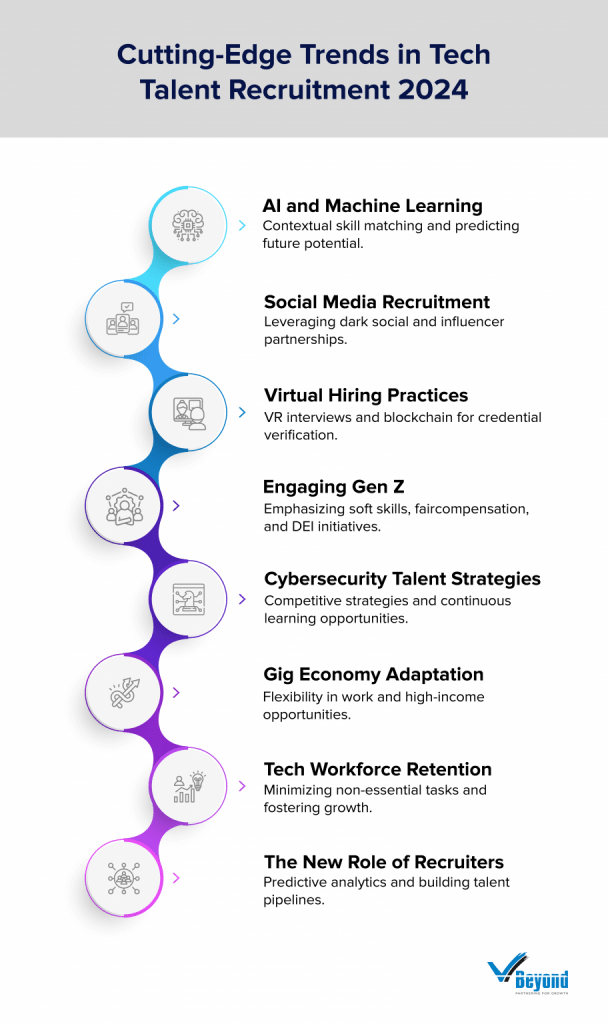How can organizations secure the best digital talent in a competitive market? What innovative trends are necessary to keep pace with the rapid advancements in the tech industry? These are crucial questions for companies aiming to lead in digital talent hiring. Midway through 2024, with the tech talent domain in flux and massive layoffs reshaping the landscape, companies must strategically innovate to attract and retain top-tier professionals behind.
Digital transformation has posed numerous challenges in attracting and retaining the right professionals to drive innovation and maintain a competitive edge. The complexity arises from the rapidly evolving tech landscape, where skills become obsolete quickly, creating a perpetual need for upskilling and adaptation. Recent massive tech layoffs, driven by economic pressures and market realignments, have added another layer of complexity. While layoffs might suggest an abundance of available talent, they also reflect the volatility and uncertainty in the market. This duality forces companies to innovate their recruitment strategies, balancing the need to find highly specialized talent with the reality of an unpredictable job market. Traditional methods are no longer sufficient; instead, companies must employ cutting-edge recruitment tactics to successfully navigate the intricacies of digital talent hiring.
This blog explores the key tech recruitment trends impacting the hiring of digital talent. It also dwells on practices for embracing the new technologies, thereby underscoring the need to adapt to workforce expectations.
Navigating the Complexities of Hiring Digital Talent
Hiring digital talent is fraught with several significant challenges that recruiters and organizations must navigate to secure top tech professionals effectively.
Rapid Technological Advancements: The tech industry is characterized by its fast-paced evolution, where today’s cutting-edge skills can quickly become outdated. Recruiters must stay ahead of these changes to ensure they are sourcing candidates with the most current and relevant expertise.
Need for Specialized Skills: As technologies become more sophisticated, the demand for highly specialized skills increases. Finding candidates who possess these niche capabilities is often challenging, requiring targeted recruitment strategies and a deep understanding of the technical landscape.
Dynamic Project Requirements and Leadership Roles: Tech projects are often dynamic, with requirements that can change rapidly. This fluidity demands leaders who are not only technically proficient but also adaptable and capable of steering projects through uncertainty and change. Identifying and attracting such versatile leaders is a significant challenge in hiring digital talent.
In addition to this, companies must also address the growing need for pay transparency and the evolving workforce expectations that demand more flexible and inclusive hiring strategies. Transparent salary practices have become a crucial factor for candidates, who now seek clarity and fairness in compensation. Moreover, the shift in workforce expectations emphasizes the need for better work-life balance, career progression opportunities, and a positive work environment. Organizations must adapt their recruitment and retention strategies to meet these new demands, ensuring they remain competitive in attracting top digital talent.
Innovative Trends in Tech Talent Recruitment
1) Artificial Intelligence and Machine Learning redefining digital hiring
According to data from Statista, the Artificial Intelligence market is projected to reach $184 billion in 2024, with an annual growth rate of 28.46% from 2024 to 2030, resulting in a market volume of $826.70 billion by 2030. The United States will have the largest market size, at $50.16 billion in 2024.
Leveraging artificial intelligence (AI) and machine learning (ML) in recruitment is a key trend for acquiring top tech professionals. Google is a big name in the tech talent acquisition game that uses AI in candidate and job profile matching.
AI tools are adept at contextual skill matching, analyzing not just the skills on a resume but also the context of their application, helping identify candidates proficient in handling complex challenges. AI can also predict candidates’ future potential by analyzing career trajectories and skill development patterns, allowing recruiters to identify emerging talent. Real-time market analysis from AI-driven tools helps companies dynamically adjust their recruitment strategies. Examples include CodeSignal, which uses AI for realistic coding assessments, and Pymetrics, which employs neuroscience-based games to evaluate candidates’ cognitive and emotional traits.
According to the Society for Human Resource Management (SHRM), US-based HR association, despite the transformative potential of AI, only about 1 in 4 employers currently use it for HR-related activities. However, adoption is rapidly increasing, particularly in large organizations within the technology, finance, and information sectors.
While there is optimism about AI’s potential to improve efficiency and collaboration, concerns about job displacement and the loss of the “human touch” remain. Overcoming these challenges requires educating HR teams about AI’s benefits, ensuring proper algorithm auditing, and integrating AI in ways that complement human interactions.
2) Social Media Upping the Game in Tech Talent Acquisition
In tech recruitment, leveraging social media goes beyond traditional job postings to utilize advanced strategies for reaching and engaging specialized talent. Microsoft is a prominent name that leverages social media effectively in its tech talent acquisition strategy.
Dark social recruitment, which involves sharing job openings through private channels like messaging apps and emails, allows recruiters to tap into trusted personal networks and find passive candidates. Social listening tools and analytics help monitor relevant online conversations and sentiment, identifying potential candidates interested in tech roles while optimizing recruitment strategies based on performance data.
Innovative approaches such as partnering with tech industry influencers and offering VR experiences enhance employer branding and candidate engagement. Influencers can amplify job postings and highlight company culture to a targeted tech audience, while VR provides immersive glimpses into the company’s work environment. Encouraging employees to create user-generated content about their tech projects and experiences builds authenticity and attracts top tech talent.
Engaging with niche platforms specific to tech professionals, such as GitHub, Stack Overflow, and Dribbble, helps recruiters connect with highly skilled candidates. Incorporating gamification elements like coding challenges and hackathons attracts tech enthusiasts and assesses their skills effectively. Using ephemeral content on platforms like Instagram Stories or Snapchat provides dynamic, real-time insights into the company’s tech culture, creating a compelling narrative for potential candidates.
3) Advanced Virtual Hiring Practices and Blockchain Elevating Digital Hiring Solutions
By leveraging advanced technologies, companies can align their recruitment processes with tech professionals’ expectations, enhancing the candidate experience and positioning the organization as a leader in innovation.
Innovative Candidate Engagement: Virtual hiring practices, such as VR interviews and asynchronous video interviews, cater to tech-savvy professionals. Google and Microsoft use VR to provide a more engaging and realistic candidate experience.
Enhanced Screening and Trust: AI-enhanced virtual assessments provide deeper analysis of technical abilities, while blockchain ensures the authenticity of credentials. Platforms like HireVue and HackerRank enhance recruitment accuracy and security.
Efficiency and Inclusivity in Recruitment: Virtual hiring events and digital onboarding solutions make recruitment more efficient and inclusive, breaking geographical barriers and reaching a global talent pool. Companies like Amazon and IBM use these technologies to streamline hiring and onboarding.
4) Engaging Gen Z: Emphasizing Soft Skills, Fair Compensation, and DEI Initiatives
Gen Z, known for their digital fluency, values employers who offer continuous learning opportunities and cutting-edge technological environments. They are attracted to roles that provide innovation and advancement in tech fields such as AI, machine learning, and cybersecurity. Companies can appeal to Gen Z by highlighting their commitment to technological advancements and offering opportunities to work on groundbreaking projects.
Emphasizing Soft Skills: Gen Z tech talent understands the importance of soft skills in driving innovation. They seek roles that foster creativity, critical thinking, and emotional intelligence. Amazon, for instance, undertakes behavioral assessment of candidates to see how they will fare in challenging situations.
Companies can use gamified assessments and virtual reality simulations to evaluate these skills dynamically. Showcasing a culture that values both technical and interpersonal skills attracts tech-savvy candidates ready to contribute to collaborative and innovative projects.
Fair Compensation and Transparency: Transparency in compensation involves clarity around career progression, bonus structures tied to performance metrics, and equity compensation such as stock options. Gen Z tech professionals value companies that transparently show how their contributions can lead to financial growth and personal development. Implementing blockchain for transparent, immutable records of compensation and performance appeals to their demand for fairness and innovation. Buffer, for example, is transparent about its salary formula and a strong proponent of equity.
Diversity, Equity, and Inclusion (DEI) Initiatives: Diversity, equity, and inclusion are non-negotiables for Gen Z. They are drawn to companies that demonstrate a genuine commitment to creating inclusive workplaces where all employees feel valued and respected. Apple, for example, has implemented several diversity programs in its engineering teams.
Beyond traditional DEI efforts, innovative strategies like AI-driven diversity analytics can identify and address bias in hiring and promotion processes. Additionally, creating virtual spaces for underrepresented groups to network and collaborate can foster a more inclusive environment. Highlighting these advanced DEI strategies can attract Gen Z candidates who prioritize working in diverse, equitable, and inclusive settings.
Statistics provided by US-based Eagle Hill Consulting highlight that 77% of Gen Z prioritize DEI initiatives when choosing an employer. By leveraging these insights, tech companies can attract and retain top talent, fostering a more inclusive and dynamic work environment.
Leveraging Technology in Recruitment: To engage Gen Z tech talent, companies must adopt cutting-edge recruitment technologies that resonate with their digital lifestyles. Utilizing AI-driven chatbots for real-time engagement, blockchain for secure and transparent application processes, and augmented reality (AR) for virtual office tours can significantly enhance the recruitment experience.
These technologies not only streamline the hiring process but also demonstrate the company’s commitment to innovation, appealing to Gen Z’s tech-centric mindset. Advanced digital tools such as diversity analytics platforms (e.g., Jopwell and Blendoor) and bias interruption tools (e.g., TalVista) provide deep insights into workforce diversity and help mitigate unconscious bias, further strengthening the company’s appeal to Gen Z.
Building an Authentic Employer Brand: Gen Z values authenticity and wants to see companies living their values, especially in tech. Highlighting open-source projects, contributions to the tech community, and sustainable tech practices can resonate deeply with this generation. Sharing real stories of tech projects that made a social impact, showcasing the company’s role in advancing ethical AI, and promoting a culture of innovation and continuous improvement can attract Gen Z tech professionals looking for meaningful and impactful work. Engaging with social media and micro-influencers who advocate for DEI within the tech community can authentically boost the employer brand, making the company a more attractive destination for top tech talent.
5) Cybersecurity Talent: Addressing Demand with Competitive Strategies
The rising prevalence of cyber threats has created an urgent demand for cybersecurity professionals, making it one of the most sought-after roles in the tech industry. IBM, for instance, gives considerable weightage to cyber security skills as part of its digital talent recruitment efforts. According to new data from CyberSeek, nearly 470,000 cybersecurity job openings are listed by US employers, yet there are only enough workers to fill 85% of these positions, indicating a significant talent gap.
To attract top cybersecurity talent, companies must adopt competitive strategies that go beyond traditional recruitment methods. Offering competitive salaries is just the beginning; tech firms need to provide continuous learning opportunities and professional development programs to keep cybersecurity experts updated with the latest threats and defense mechanisms. Implementing certifications and advanced training modules as part of the career development plan can be a significant draw for cybersecurity professionals who prioritize growth and skill enhancement in their roles.
Moreover, building a robust cybersecurity presence requires innovative talent acquisition strategies. As competition for talent grows across sectors, companies must develop alternative pathways to careers in cybersecurity that cultivate diverse talent. Initiatives like regional alliances and multistakeholder partnerships can strengthen coordination and collaboration to meet workforce needs and bolster local economies. Highlighting these efforts in recruitment materials can attract candidates who are passionate about making a meaningful impact in the fight against cyber threats.
6) Adapting Gig Economy: Flexible Work in Challenging Times
The tech layoff wave continues to impact the industry significantly in 2024, with over 74,377 job cuts reported from January to May alone, according to Layoffs.fyi (source: TechCrunch). Major tech companies like Microsoft, Google, TikTok, Snap, and Amazon have conducted sizable layoffs in the first half of the year. For instance, Microsoft is reportedly cutting hundreds of employees in its Azure cloud business, while Google is making large cuts globally across several of its Cloud teams. Smaller startups have not been spared either, with companies like OrCam, Tropic, and SeekOut also implementing layoffs. This trend underscores the ongoing challenges in the tech sector, where companies are adjusting to economic pressures and evolving market conditions.
Amid these massive layoffs, the gig economy presents a resilient alternative for tech professionals, according to Forbes. The gig economy allows tech professionals to engage in multiple projects simultaneously, providing a steady income stream and the opportunity to diversify their skills. Flexibility is particularly appealing to younger tech workers who seek a balance between professional growth and personal life.
Additionally, a significant portion of tech gig workers earn high incomes, demonstrating the financial viability of this work model. Tech gig workers also tend to display greater resilience and optimism compared to their salaried counterparts. Despite lacking traditional benefits like insurance or pensions, 85% of tech gig workers willingly accept these roles because they value the flexibility and work-life balance they provide. This model also mitigates the high turnover rates and continuous need for upskilling associated with traditional tech roles, making the gig economy an attractive and stable option for top tech talent.
7) Tech Workforce Retention: Winning Strategies
Management consulting firm OliverWyman observes pointedly: given the significance of technology in every part of the business today, leaders cannot afford to let the workplace function as a “constant revolving door for tech talent”.
One of the most effective strategies for retaining tech talent is to ensure that technologists can focus on their core competencies without unnecessary distractions. Companies should strive to minimize non-essential tasks that take time away from core engineering activities, such as excessive administrative duties or repetitive meetings. By streamlining processes and reducing “toil,” organizations can keep their tech teams motivated and focused on meaningful work. This approach not only boosts job satisfaction but also enhances productivity, making technologists feel that their time and expertise are truly valued.
In addition, fostering a supportive and growth-oriented culture is crucial for retention. This involves actively listening to employees’ career goals and providing clear paths for advancement, whether through management roles or technical specializations. Regular feedback mechanisms, such as 360-degree reviews, can help ensure that all employees feel heard and appreciated. Moreover, equipping technologists with the latest tools and technologies demonstrates a commitment to their professional development and productivity.
8) Talent Strategists: The New Role of Recruiters
The role of recruiters, like VBeyond Corporation, is expanding far beyond traditional hiring to become pivotal in shaping organizational success. These professionals are now integral to workforce planning and the development of future skill sets essential for technological innovation. By leveraging advanced predictive analytics, recruiters can anticipate not only immediate hiring needs but also future talent requirements, enabling companies to proactively build a pipeline of skilled tech candidates. This strategic foresight ensures that organizations are well-prepared for emerging technological trends and market shifts. Moreover, recruiters play a crucial role in employer branding, creating compelling narratives that resonate with top-tier tech talent. By understanding the unique aspirations and motivations of tech professionals, recruiters can craft targeted outreach and engagement strategies, making the organization more attractive to high-caliber candidates.

Conclusion
Effective tech talent recruitment demands a multifaceted approach that blends advanced technology with a nuanced understanding of the industry and its workforce. Leadership must remain proactive, continuously updating their knowledge on technological advancements and industry trends to align recruitment strategies with the evolving landscape. Utilizing AI and machine learning for precise skill matching, blockchain for secure credential verification, and immersive VR for engaging candidate experiences are key components. Equally important is fostering a culture of continuous learning, emphasizing the value of soft skills, and ensuring transparent and fair compensation practices. By understanding the mindset and aspirations of tech professionals, leaders can create a dynamic and attractive environment that not only attracts top talent but also retains and nurtures them for long-term success.
Discover how our innovative recruitment solutions can help you secure top tech talent in 2024. Contact us today to learn more about our specialized digital hiring services and start building your future-ready team!


